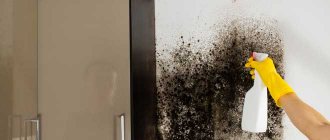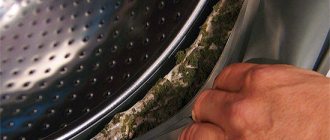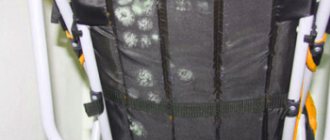It happens that you put things in the closet, clean, fragrant, but after some time you take them out, and an unpleasant smell emanates from them. It seems that they were in the pantry for six months, and were not stored at home. This is mold. In an attempt to get rid of it, many people take things out into the fresh air to ventilate.
This is enough until the clothes are returned to the room again, and if the smell is too strong, it doesn’t help at all. Where does this nuisance come from, how to eliminate it, how to make wardrobe items smell fragrant again and how to store them correctly - it’s time to find answers to these questions.
How to get rid of the smell of mold on things using household chemicals
If traditional methods do not help to cope with mold, or you want to get the desired result quickly and with a minimum of effort, you can use household chemicals. Specialized products have a special composition that completely eliminates any fungus and allows you to remove a bad musty smell.
Read also: What to make from scraps of fabric
- Bleach. The easiest option to remove fungus from light-colored items is to wash them in bleach. There are a lot of specific products, and the instructions for them look approximately the same. A small portion of bleach, about 100 ml, should be added to 4-5 liters of water, then soak the items for half an hour and then put them in the washing machine.
- Vanish clothing cleaner. If classic bleach is intended for white and light fabrics, then with the help of Vanish you can remove mold on colored and dark things. Use the product according to the instructions on the package - usually the cleaning agent must either be added to the powder in the machine, or diluted in water and soaked before washing.
- PureWasher. An effective cleaner with disinfectant and fragrance properties. The main advantage of PureWasher is that the product is suitable for any fabric - dark and light, coarse and fine. If you add the product to the washing powder according to the instructions for automatic washing, you can remove the smell of mold in just one procedure.
Advice! Specialized products that help remove the smell of dampness often have a rather aggressive composition. Before treating damaged clothing, it is recommended to apply a small amount of the chosen product to an inconspicuous area of the fabric and make sure that the bleach or cleaner will not harm the color and structure of the item.
How to add a pleasant aroma
To give things a special smell that is pleasant to the owners, the simplest methods are used - regular washing, aromatic substances.
Important: fragrances pleasantly refresh things if they are free of foreign odors. Combining an unpleasant amber with any scent will only make the situation worse
Cleanliness support
The best and most reliable way to make things smell pleasant is to keep the entire contents of your closet clean. Worn items should be stored separately. For them, it is better to allocate a separate chest of drawers, a bedside table, and not a shelf in a common wardrobe.
Periodic revision of clothing
Everything in the wardrobe must be ventilated regularly. This applies not only to fur products, which protect against moths in this way. It’s worth setting aside a day and taking out all the things from the closet and shaking them out. Unused items should be thrown away or moved to distant mezzanines.
Humidity level
To reduce humidity in cabinets, use salt, soda, silica gel, rice, and zeolite. Special moisture absorbers are produced, which are used if other methods do not help.
Coffee beans
The aroma of coffee can overpower many odors. The grains need to be roasted and placed in the wardrobe, whole or ground. Wooden cabinets preserve the coffee spirit for a long time; clothes and linens are also saturated with it.
Essential oils
Your favorite essential oil is dripped onto the fabric and left in a closed wardrobe. Gradually, all things acquire this aroma.
Professional products
When previously taken methods to eliminate an unpleasant odor did not help, you need to turn to the chemical industry for help. The following products can be purchased in the store:
- Flavored water. An effective remedy in the fight against unpleasant moldy odor from clothes. It is sold in the hardware departments of supermarkets. It is based on natural ingredients - medicinal herbs. If you add this translucent liquid to the rinse compartment, then after a normal wash cycle, not a trace of the smell will remain.
- Sodium borate. The product is also called “borax”. It is purchased at hardware stores and used to soak laundry. Prepare a solution: 40 g of sodium borate and 1.5 liters of water. Dip things into this liquid and cover the bowl with cling film. After 3-4 hours, the clothes are put into the machine and washed in the usual cycle using regular powder and rinse aid. Clothes are dried after “cleaning” on a radiator or in the fresh air.
Read also: Hairstyles for girls
These methods do not require large material costs.
Emergency help: removing odors without washing
There are times when there is no time or it is undesirable to wash. For example, you don’t want to throw a clean thing into the dirty just because of the aromas that it has absorbed. Or you need to put on a blouse, but before leaving you discover that your armpits smell of sweat. What to do in such situations:
- Place the item carefully in a plastic bag and place it in the freezer for 20–30 minutes. Cold temperatures do a great job of eliminating organic odors.
Cold temperatures are great for removing organic odors from clothing. - Pour vodka into a spray bottle, generously spray the item or problem area until wet and hang it on the balcony. Vodka evaporates quite quickly, and with it an unwanted aroma. If you are in a hurry, dry it with a hairdryer.
I haven’t tried the freezer, but vodka somehow helped me out. I didn’t dare to perform this trick several times in a row with the same blouse, but for one evening it worked 100%.
Use of household chemicals
You can cope with the problem using fabric conditioner. It is best to use flavored formulations, for example:
- Vernel Freshness of a summer morning or Vernel Aromatherapy of serenity, their cost is about 200 rubles per 1 liter;
- Porinse Aroma conditioner with violet scent for 300 rubles;
- concentrated fabric conditioner Lenor Alpine meadows, its cost is 160 rubles.
Regular white removes odor well, but it must be used carefully so as not to damage the fabric fibers. You can also soak things in a solution of laundry soap for half an hour, and then wash them as usual.
Effective sweat odor neutralizers
The smell of sweat ingrained into fabric is a common problem. Even those who don’t go to the gym or physically work all day are familiar with it. Often worn items in the armpit area one day begin to exude body odors even after washing. This is explained by the fact that, along with the sweat glands, fatty glands also actively function. Molecules of sweat and fat mix on the threads of fabric, and the powder is not always able to break them down. Dishwashing liquid, soda, vinegar, lemon or aspirin can cope with this task:
- Make a solution using one of these products and soak your clothes in it before washing. You can simply add soda or crushed 4-6 aspirin tablets to the powder, and use lemon juice or vinegar as a rinse.
- Make a paste of baking soda or aspirin tablets with water and rub into the armpits, leaving for several hours. Then wash it.
Baking soda and aspirin eliminate sweat odor from the armpits
Household chemicals
The easiest way to get rid of the smell of dampness and mold on clothes at home is by using household chemicals. The following tools are suitable for this:
- Bleach. Ideal for adding freshness to white items. Eliminates odors of mold and dampness from clothes, prevents the formation of fungus.
- Stain remover. Suitable for removing heavy stains on any fabric.
- Antifungal agents Valo, Prosept, Element. Sold in specialized departments or online stores. Designed to combat mold and other types of organic tissue damage.
- Conditioner or rinse aid. Gives laundry a pleasant aroma and helps remove the smell of dampness from clothes when washing.
Along with any type of detergent, washing powder is used to eliminate mold and traces of dampness. It is selected depending on the type of fabric, but when washing with additional substances it is added in smaller volumes.
Methods of disposal
The most common way to eliminate the smell of dampness on fabric is regular washing. It makes no difference whether in the washing machine or by hand. Of course, the first method is much simpler. You should also consider the type of fabric so that you know how long to wash it and how much product to put in. After this, depending on the type of fabric, it needs to be ironed on both sides.
Folk remedies
Any housewife who has declared war on dampness first of all grabs at folk remedies that work very effectively:
- Iodine - You can use it to get rid of unpleasant odors in your wardrobe. To do this, place a bottle of iodine on a shelf with clothes, with a piece of cotton wool plugged in instead of a lid. You just need to make sure that the bottle doesn’t accidentally fall and stain everything around it. After some time, the “aroma” of dampness will disappear forever.
- Herbs, aromatic soap - They are simply placed between things or hung. After a short time, a pleasant fragrance appears in the closet. But this method will not help get rid of mold, it will simply disguise its presence.
- Citrus fruit peel - Orange peel works best to create a New Year's scent on clothes. To do this, it is placed next to things. The peel should not be hidden in them, otherwise a yellow spot may appear on the fabric.
- Ammonia, turpentine - Will help get rid of dampness on fabric made of wool or silk. To do this, dissolve 10 ml of ammonia or turpentine in 150 ml of water. Soak a cotton pad in it and wipe the moldy area on the fabric with it. After ten minutes, wipe again and immediately rinse in plain water. Then dry in the fresh air.
- Curdled milk - You can use it to remove moldy areas from cotton, calico, satin and linen. To do this, they are soaked in yogurt for about an hour, after which they are washed as usual.
- Onions - Rub it on a smelly spot on cotton, satin or calico, then wash it by hand or in a machine.
Household chemicals
If folk remedies do not help, then in this case properly selected household chemicals can help:
- Scented water - During washing, any powder is poured into the powder compartment, and scented water is poured into the conditioner compartment. The result will exceed all expectations.
- Sodium borate - Prepare a basin for soaking. 60 grams of sodium borate are dissolved in two liters of water. After which the clothes are soaked in it, the basin is covered with a lid or film and left alone for four hours. Then rinse well and wash in the washing machine.
Outerwear
At first glance, it seems that it is very difficult to get rid of the “aroma” from outerwear. It's actually a simple procedure:
- Soap solution - Will help get rid of the stench on the skin. To do this, dissolve soap in water and pour this solution into a spray bottle. Then they spray the skin generously. Leave for half an hour. Then simply wipe with a damp cloth. Can be repeated if necessary. You can replace this soap solution with a mouth rinse.
- Talc from lavender flowers - Use it to get rid of the “aroma” of dampness on a fur coat. To do this, all the fur is covered with this talcum powder and hung on the balcony to air. You can hang a bag of dried lavender nearby.
Mold smell on light-colored fabrics: methods of getting rid of it
Light colors can be treated with chlorine bleach. It is very important to carefully read the instructions for use so as not to damage the fabric. It should also be remembered that too frequent use of bleach can lead to the formation of unsightly stains on the product being treated.
Hydrogen peroxide is also good for removing damp odors and mold stains from things at home.
To do this, just pour a 3% solution onto the dirt and leave everything for 2 hours, then wash everything in the usual way.
Another method of removing odor is ascorbic acid dissolved in 50 ml of alcohol. The solution must be applied evenly to the affected surface for an hour, then wash the item and the stains will disappear.
Prevention measures
Unpleasant odors from clothes will not appear if you follow the rules for washing, drying and storing them. Do not put clean and dirty items in the same closet. Poorly dried laundry should not be placed on shelves. Periodically, fabrics, sheets, and wardrobe items must be ventilated.
Wardrobe shelves must be treated with a disinfectant solution. Odor absorbers are placed inside the boxes and drawers.
The machine must be wiped and dried after washing. Washed items are removed from the drum immediately after the cycle is completed.
Preventing the appearance of damp and mold odors on clothes
It is easier to prevent the unpleasant stench of dampness on things than to try to remove the musty amber from fabric. The following measures will help protect things from mold.
- After washing, clothes should be put in the closet only after they are completely dry. If things are at least a little damp, then the question of how to get rid of the smell of mold on clothes will very quickly arise.
- A closet with clothes must be regularly disassembled, ventilated and moved things from place to place - this helps to avoid the appearance of dampness. Cabinet shelves should be wiped with disinfectants - hydrogen peroxide or vinegar solution.
- If the humidity in the apartment is high and there is constantly not enough sunlight, you need to ventilate the room more often, otherwise the appearance of a mold aroma will not be avoided.
- Twice a month, when washing, you should add a little baking soda to the washing powder for preventive purposes. Baking soda will not only prevent the appearance of a damp aroma on the fabric, but will also protect the internal parts of the washing machine from mold.
If possible, items should be ironed after washing, after which they will definitely become completely dry.
Reasons for the appearance of unpleasant “amber”
If you smell a heavy perfume from your wardrobe, mezzanine or laundry taken off the line, first of all you need to understand why it appeared. Among the reasons for the musty smell emanating from things are:
- Washing machine. In the absence of preventive cleaning and ventilation, bacteria multiply on the rubber gaskets of the device. The “aroma” from the products of their vital activity permeates the parts of the machine and is transferred to the laundry loaded into it. In this case, eliminating the unpleasant odor from the washing machine will help.
- Sweat-smelling wet items (especially socks). If they end up in the drum along with other wardrobe items, often after drying all the clothes, usually synthetic, acquire an unpleasant odor.
- Washed items left for a long time in the machine drum.
- Prolonged drying of large items (blankets, blankets, coats) indoors.
- High humidity. Darkness and dampness are an ideal environment for the growth of mold fungi, which cause the corresponding smell. If the closet with things is in a damp room or unheated country house and is not ventilated for a long time, an unpleasant odor cannot be avoided.
- Clothes and bedding placed in storage undried.
- Condensate. It appears on synthetic and wool items that are stored in plastic bags where there is no air circulation.
- Items just taken out of the iron and stacked in tight piles in the closet.
- Worn or dirty clothes accidentally found among other items of clothing.
- Packed items that haven't been used for a long time.
As you can see, the main factors causing the problem are dampness, dirt, and lack of air circulation.
Chemical odor removers
Special formulations will help eliminate unpleasant “odors.” Some cleaners must be handled with care. On factory products, there are step-by-step instructions that indicate how to get rid of the smell of dampness in clothes using a specific preparation.
In order not to spoil things, the effect of the composition is first tested on a small piece.
Odor absorbers include:
- Chemical preparations containing ethyl alcohol. The composition is sprayed using a spray bottle over the surface of the material, and then the clothes are ventilated.
- Baking soda. Powder is poured onto moistened tissues. The substance is rubbed into the cloth and then removed with a soft brush. Blankets and other large items are shaken out, and small items are rinsed in warm water.
- Table vinegar 9%. The product is diluted with water 1 to 3 and sprayed onto the material using a spray bottle. The composition is kept on the fabric for 5-10 minutes, then the items are rinsed and dried.
- Potato starch. This product is used to clean and remove odors from fur and wool products.
- Drunk coffee. The product is suitable for processing black and brown fabrics.
Useful tips
To get rid of the damp smell from linen and clothes, you do not need to use several methods at the same time. It is enough to use one that is more suitable for you. If it doesn't help, try the second one.
Things must be dried in the sun during the off-season.
For example, before putting away winter overalls/fur coats/down jackets, dry them thoroughly in the sun on both sides and only then put them in the closet. It’s even better to put them away in special bags or covers.
To combat the smell of dampness in your shoes, you must dry them after each hike. This can be done with electric dryers or, the old-fashioned way, by stuffing large pieces of newspaper. Paper absorbs moisture well. To eliminate odor, you can use special sachet balls.
Preparations for treating outerwear
The most difficult thing is to remove odors from pile products. Fur coats and coats cannot be washed. Outerwear is dry cleaned. At home, you can try to refresh the fur using:
- A solution of vinegar with ammonia (use 1-2 tsp of substances per 1 liter of water). Apply the composition to the lining with a clothes brush, then air the treated items.
- Soap solution. Grated laundry soap (1 third of a bar) is dissolved in 500 ml of water, whipped until foamy. The resulting composition is used to clean fur and lint.
- Alcohol, vodka. The product is sprayed onto outer clothing. Things are hung out to air in fresh air.
Important! An attempt to drown out musty aromas with the help of perfumes and colognes leads to the opposite result. The smell becomes more noticeable.
What should you do to prevent your clothes from smelling damp?
Prevention against dampness on clothes:
- Check the rubber ring in the machine. If mold is found, it should be washed and dried. Do not close the machine door. This method will help prevent mold from growing.
- Clean the closet with a solution of vinegar and water once a month.
- Do not put things in the closet unless they are completely dry.
- Air dry, then iron at high temperature.
- Mix soda with disinfectant powder 1-2 times a month.
By following the rules, you can avoid unpleasant odors and mold. If the smell of dampness does arise, it is necessary to use available means such as soda, vinegar, and ammonia. In case of serious tissue damage by fungus, “Whiteness” or “Vanish” will help.
The article has been verified by the editors
Dry cleaning
Sometimes dry cleaning is all you need to get rid of the musty smell from your clothes. This will help if there is no visible contamination. Possible types:
| Dry Cleaner | Method of application |
| Soda and potato starch | Sprinkle on clothes, rub in, let sit for 10-30 minutes and shake off. |
| Stain remover pencil | Use according to instructions on individual areas of the item. |
| Clay | Apply as soda or additionally iron after rubbing into the fabric. |
| Dry cleaning products | They not only get rid of the smell of dampness and mold, but also remove dirt. Use according to instructions. Can be used in a washing machine on drying mode. |
Dry cleaning products, with the exception of dry cleaning, are suitable for adding freshness to laundry or when a full wash is not possible. They can also be used to prevent the formation of mold and dampness in clothes that have not been used for a long time and are stored in a closet.
Remove odor from clothes
What is important is a correct understanding of the problem. It is quite possible to kill the unpleasant stench if you rub your clothes with citrus peel or put aromatic oils, salts or even a smoking incense stick in the closet with clothes.
This will not fix anything, and will not save you from odors, it will only kill it for a short time, and then only for the person who is in contact with the things, the unpleasant smell will simply be erased from perception. Those around you will still feel the whole bouquet of dope. It is necessary to get rid of the cause.
Each fragrant substance stuck in the fabric fibers and constantly stinking requires its own approach and its own method of elimination. However, the principle remains unchanged: it is necessary to decompose and completely remove the substance that produces the odor.
Let's try to list the most persistent and irritating odors, as well as ways to get rid of them:
- The smell of tobacco, cigarette smoke. It is better to use special preparations to remove nicotine and tobacco smoke. The tars in cigarette smoke are very persistent, and not every cleaning composition can remove them. You should try laundry soap and vinegar or hydrogen peroxide; it is quite possible that ammonia will help get rid of the smell.
- Sweat. As with any organic material, hydrogen peroxide works well with sweat. In addition, vinegar and citric acid can remove and actively eliminate persistent odors. These are light acids that can break down especially odorous enzymes and disinfect tissue. One of the problems with odor removal is the presence of fats secreted by the sweat glands, so if the stench of sweat is not eliminated for a long time, then it is worth combining with dishwashing detergent. You can remove a sweat stain using the following instructions.
- Mold and dampness. First of all, it is advisable to dry clothes with a damp smell well and warm them in the sun, this will improve the situation and most likely, after regular washing and re-warming in the sun, they will help get rid of the smell. An alternative could be freezing or airing outside in severe frost. For the rest, the following will help get rid of fungus and mold: vinegar, ammonia, citric acid, hydrogen peroxide, and table salt or another very strange remedy - ascorbic acid dissolved in vodka.
- Fish. The only effective cleaning tools in your household arsenal are vinegar and a saturated saline solution. In addition to it, you can use special chemicals. compositions for removing and reducing odors that can be found in a hardware store.
- The smell of second-hand goods. The reason for such a disgusting smell is the aggressive and poisonous formaldehyde and methyl bromide. Prolonged airing in the sun will help get rid of them, if this is permissible for clothes before and after washing. Also effective is a solution of ammonia, in which you have to keep the clothes for at least 2-3 hours.
- Gasoline and diesel fuel. Various adsorbents and simply substances capable of absorbing odors, such as soda, table salt and activated carbon, can help. It all comes down to allowing the gasoline to evaporate during prolonged ventilation in an open space. In traces of gasoline, the odor lasts the longest due to additives and impurities, the same applies to diesel fuel, only to a greater extent. The situation is saved by purified Galosha gasoline, available at any household. store. It will wash away the residue from the stain, after which weathering will be much more active.
Now all that remains is to analyze all the indicated options on how to remove odor from clothes for various fabrics using improvised means.
It should be noted right away that with a 99.9% probability they will be able to effectively get rid of unpleasant odors using chemicals. cleaning, where they know exactly which chemical compounds should be used and in what situations. So if the item is dear to you, and the desire to experiment is not too high, then it is better to entrust the fate of the clothing to professionals. Although you will first have to determine which laundry or dry cleaning service near you has these same professionals. A good source of information can be the city portal and forums, where many responsive clients have probably described the features of the work of a particular office in the city.
Features of treating various fabrics against mold
Correctly remove the unpleasant smell of mold from clothes - take into account the color, type of fiber:
- For white, light-colored fabrics, the use of compounds with chlorine, peroxide, and bleach is allowed.
- For colored materials, a solution of ammonia and water is suitable.
- Wash leather items with powder and laundry soap.
- Ventilate fur coats and fur products in the wind, dry them in the wind. If the tag is washable, add sterilizer to the machine. Then thoroughly dry and ventilate, and treat with a steamer.
The second hand smell can be eliminated using this method:
- Sort by color.
- Add 50 ml of ammonia to the basin.
- Keep synthetic material for up to 6 hours, cotton and calico for up to 3 hours.
- Squeeze and hang on the balcony.
- The condition is that the moisture must leave, only wash the product afterwards.
- Rinsing involves adding fragrance and conditioner.
Interesting methods for skin:
- If there is mold on a leather bag, use cotton wool soaked in vinegar. Put it inside. Wrap the product in polyethylene. Leave for 6 hours. Then ventilate thoroughly;
- For leather shoes, do the same procedure. But the exposure time for vinegar should be 24 hours. Afterwards, remove the cotton wool and wipe the inside with ammonia.
You can thoroughly air your boots and treat them with shoe deodorant.
The sun and air are your best friends
Do you need to keep your clothes fresh without washing them? Then you should trust nature. Bad odor is the result of microbial activity. During the day, sweat and dead skin cells fall on the fabric of clothing, which become an ideal habitat for various bacteria. It is the activity of pathogenic microorganisms that causes the smell.
Sometimes it’s enough just to hang the outfit for a few hours in the yard or on the balcony. The ultraviolet rays of the sun have disinfecting properties and have a detrimental effect on bacterial cells. At the same time, the wind helps remove “odor” molecules from the fabric. This method is especially effective if you need to cope with the smells of the kitchen (your clothes are literally saturated with them after cooking, gatherings in the kitchen or even in a cafe) and cigarettes.
Swiss scientists have named two berries that slow down the aging of the body
A man noticed a pile of unusual “sand” on the shore: he approached it with a camera
My husband was surprised to see what beauty I made for the New Year from a double boiler
General rules for getting rid of damp smells
Specific ways to remove the smell of dampness from clothing may depend on the material it is made of. However, some methods are universal, so they can be applied to any item of clothing.
Ventilation
Dampness appears in the cold season, so it is mainly the summer wardrobe that suffers from it. These things are practically never taken out of the closet, so they absorb unpleasant notes. As a preventative measure, it is necessary to dry it once a month. This method will also help with the aroma that has already appeared.
You need to air your clothes in the sun in clear weather. In winter, “freezing” your wardrobe will be as effective as airing it in summer. Things should dry for several hours, after which the smell should disappear. The appropriate weather conditions can be simulated at home. For example, putting a T-shirt in the freezer or hanging shirts in a room and pointing a heater or fan at them. Unfortunately, this method does not work equally well with all fabrics. Instructions on how to rid towels of the smell of dampness include a more aggressive action such as boiling.
Newspaper method
A housewife who is going to remove the smell of dampness with the help of newspapers must be patient. This drying process takes about 5 days, but anyone can do it. You need to take dry sheets of newspaper and cover your clothes with them. The newspaper should not be a stamp, so as not to leave traces of printing ink on the fabric.
The paper should be inside the garment, but it can also be wrapped around it. This method can be used to prevent dampness if it is not possible to frequently ventilate things.
Soda
Any item can be sprinkled with baking soda and left for several hours. You need to sprinkle it on both sides so that the baking soda absorbs all the excess moisture and smell. Some housewives advise not to sprinkle it on clothes, but simply leave it in the same container with an open package of soda for a day. After the soda has absorbed all the aroma, you need to clean the clothes either by washing them in a machine or using the dry method.
Soda can be used in other cases. For example, if things smell damp after washing, then the problem may be in the washing machine or the mold spores have not been washed out of the fabric. In this case, you can add an equal amount of soda to the washing powder or instead of it. It is a disinfectant, so it will remove odor even in the most difficult cases. However, the product is quite aggressive, so it cannot be used on delicate materials.
Steam cleaning
A steam cleaner, just like baking soda, is a good disinfectant. That is why there is no damp smell left after it. It's worth noting that this only applies to the standalone steam cleaning device. Irons with a similar function can achieve this result only with the use of additional substances.
Household chemicals departments sell aromatic liquids for irons. They are poured into the water hole, after which the clothes must be ironed using the steam function. Delicate fabrics are ironed through paper or gauze. After ironing, items should rest as a small amount of moisture remains in them.
Rules for storing things
Proper storage will help avoid the appearance of unpleasant odors in cabinets:
- regular removal and ventilation of the entire contents of the wardrobe (1-2 times a year);
- keeping the cabinet clean - removing dust, drying, treating with disinfectant solutions against fungus;
- removing unused items from the wardrobe;
- separate keeping of clean and worn clothes - the smell of sweat, deodorants, the street will gradually permeate everything clean;
- keep the doors closed so that the smell of the kitchen and other aromas do not penetrate into things; It is periodically useful to open for several hours - the air in a closed space stagnates, microbes multiply;
- Dry clothes and ironed linen thoroughly before placing them in the wardrobe;
- protect the cabinet from pets;
- combat high humidity in the apartment (recommended - 40-60%).
Fragrances are used to add a fresh touch to clean linen, and not to mask a bad odor.
Proper storage of things and care for their safety will make the house clean and healthy. Bad odors are harmful to health, make the air in apartments musty and heavy, and provoke the development of respiratory diseases and allergies.
Wet cleaning
Cleaning with disinfectants and compounds that absorb foreign “odors” will help get rid of the heavy musty smell from clothes. Some cleaners are safe for all fabrics, but others need to be used with caution after testing them on a small area of the material first.
Universal means
Universal odor absorbers include:
- Ethyl alcohol and products containing it (uncolored). The liquid is poured into a spray bottle and sprayed onto the clothing that requires treatment. Pure alcohol is diluted 1:1 with water; drinks containing it, for example: vodka, are not diluted.
- Baking soda. Lightly moisten things using a spray bottle. Then soda is sprinkled on their surface. Using a soft brush, rub the powder into the fabric without pressing and leave for a quarter of an hour. Cleaned large items are thoroughly shaken out, small items are rinsed.
- Table vinegar. A product of 9% concentration is diluted with water 1 to 3 and sprayed onto the fabric. After 10 minutes, the items are dried or sent to the wash.
- Potato starch. As a rule, this product is used to absorb odors from items with pile and knitted fabrics. The powder is scattered over the front side of the model, and after a few minutes, shaken out.
For processing dark clothes without mold stains, the grounds from just drunk coffee are suitable. It is distributed over the surface in an even layer and brushed off after drying.
For light things
You can remove the smell of dampness from clothes made of white material as follows:
- Ascorbic acid is dissolved in a quarter glass of alcohol. The clothes are wiped with a cotton swab soaked in the composition and left for 1 hour. After this, washing is done in the usual way.
- 3% hydrogen peroxide is diluted with warm water in a ratio of 1:10. The fabric is treated with this composition, and after a few minutes it is rinsed or wiped with clean water several times.
- An aqueous solution of ammonia is applied to the products (1 teaspoon per 1 liter). After 10 minutes, they are hung out to air or washed.
- Moisten a cotton pad with a mixture of ammonia, table salt and water (5 ml, 30 g and 200 ml, respectively) and wipe the bad-smelling material with it. After treatment, wardrobe items are sent into fresh air for several hours.
Although these products are gentle, they can only be safely used to eliminate musty odors from clothes made of thick fabrics. Delicate fabrics should be tested before processing by applying the substance to an inconspicuous area of the product, for example: an inner seam or lining.
For woolen coats and fur coats
The issue of removing the smell of dampness from woolen coats and fur coats deserves special attention. If this problem occurs, such wardrobe items should be dry cleaned. If you decide to refresh them at home, do it in the following sequence:
- 1-2 tsp. Table vinegar or ammonia is diluted in 1 liter of water. Soak a clothes brush in the solution and treat the lining of the item hung on a hanger.
- A quarter of a bar of laundry soap is grated. Beat the shavings in hot water (0.5 l). The resulting foam is used to clean the front side of the item.
- Wipe the pile with solution No. 1.
- Use a spray bottle to spray diluted ethyl alcohol or vodka onto a fur coat or fur coat.
- Hang clothes out in the air for 48 hours.
Don't try to solve the problem with deodorants or perfumes. The mustiness will not only not go away, but will become even more noticeable.
Soaking, washing, boiling
If things smell damp after washing or improperly drying, the surest way to get rid of the moldy “amber” is to completely immerse them in water. Before any method of washing or boiling, soaking in one of the following compositions is recommended:
- Borax solution (40 g per 1.5 liters of water). Processing time – 3-4 hours.
- A mixture of table vinegar and water (1 tbsp per 1 liter). Things are soaked in this solution for one and a half to two hours.
- 3% hydrogen peroxide diluted with water (100 ml per 1 l). The processing time for clothing should not exceed 10 minutes.
- 30-50 g of baking soda or salt added to hot water (1 l). Clothes that smell of mold are kept in the mixture for half an hour to two hours.
After soaking, you can boil white models made of linen or cotton fabric with soda, laundry soap, lemon juice or “Whiteness”.
When washing by hand, one of the additional components is added to the detergent:
- 30 g borax;
- 60 g soda;
- 1 tbsp. l. vinegar.
These products can also be placed in the machine’s ditch along with washing powder. In addition, it is recommended to drop a little aromatic oil into the rinse conditioner, for example: tea tree, lavender or citrus.
If the source of mustiness lies in the washing machine, it must be treated with a disinfectant before washing again. Parts that are heavily damaged by bacteria may need to be replaced.
How to properly store clothes so they don't get damp
After having to fight an unpleasant odor, find the causes of its occurrence and eliminate them, you don’t want your favorite things to start smelling of dampness.
In order not to think about how to remove the smell of mold from clothes, follow a few simple rules of care and storage :
- Designate separate shelves in your wardrobe for freshly washed items and for worn ones.
- Make sure the clothes are completely dry before storing them in the closet.
- After wearing, do not immediately put things in the wardrobe. The ideal option is to let them hang in the fresh air. If this is not possible, just hang them somewhere in the room.
- Despite the opinion of modern housewives about ironing as an unnecessary procedure, try to go over things with an iron before putting them in the closet. But only those that can be ironed!
- Before storing seasonal items for long-term storage, be sure to wash them. And ventilate the clean ones. And let them hang in the sun's rays.
- Store clothes only in places where there is no source of dampness.
- Take care of your machine: after washing, take things out immediately, wipe the area under the rubber band with a rag and leave the door open.
- Periodically remove all items from the wardrobe, wipe the shelves with alcohol and ventilate.
- Sometimes, for prevention, add one of the products described above when washing. For example, vinegar, onion juice, soda.
Tip: to make things smell nice, you can put soap wrapped in a thin cloth, an empty perfume bottle, or a strip of paper with a few drops of aromatic oil in your wardrobe.
Now you know how to remove the smell of dampness from clothes, how to find the cause of its appearance, eliminate it and no longer encounter the problem. There's nothing complicated about it. The main thing is to properly care for your clothes, wardrobe and washing machine. Then your clothes will always smell fragrant. Let household chores bring you pleasure!
You can get rid of the smell of mold on clothes using many methods; you don’t have to throw things away. Fungus and the corresponding unpleasant aroma are eliminated by both chemical and natural household products.
Preventive measures
The appearance of mold is a dangerous and harmful phenomenon to human health and life. It occurs very often in everyday life. There are many reasons and factors for its occurrence. Dealing with the consequences is always difficult. It is especially difficult to get rid of disgusting smells on clothes. Therefore, it is useful to know about preventive measures - they will help prevent the occurrence of mold.
Clothes must be kept clean. After washing it must be dried thoroughly. To be more effective in preventing the formation of fungi, ironing should be used. The room in which the wardrobe or shelves for storing clothes is located must be warm and dry. Low temperatures and high humidity promote the emergence and proliferation of harmful microorganisms.
It is important to ensure that contaminated clothing is not placed together with clean clothing. If it is not possible to wash heavily soiled items in the near future, they should be dried so that they do not start to stink and placed in a special container for storing dirty laundry. The clothing container should be regularly treated with antibacterial agents and dried thoroughly.
Mold is an unpleasant and dangerous phenomenon. It has a specific nasty smell. Clothing damaged by such parasites cannot be worn. This causes discomfort to the owner and people who will be near him. However, you should not rush to get rid of your favorite shirts, dresses, trousers, coats or jackets. There are many methods and instructions that will tell you how to remove the smell of dampness from clothes.











